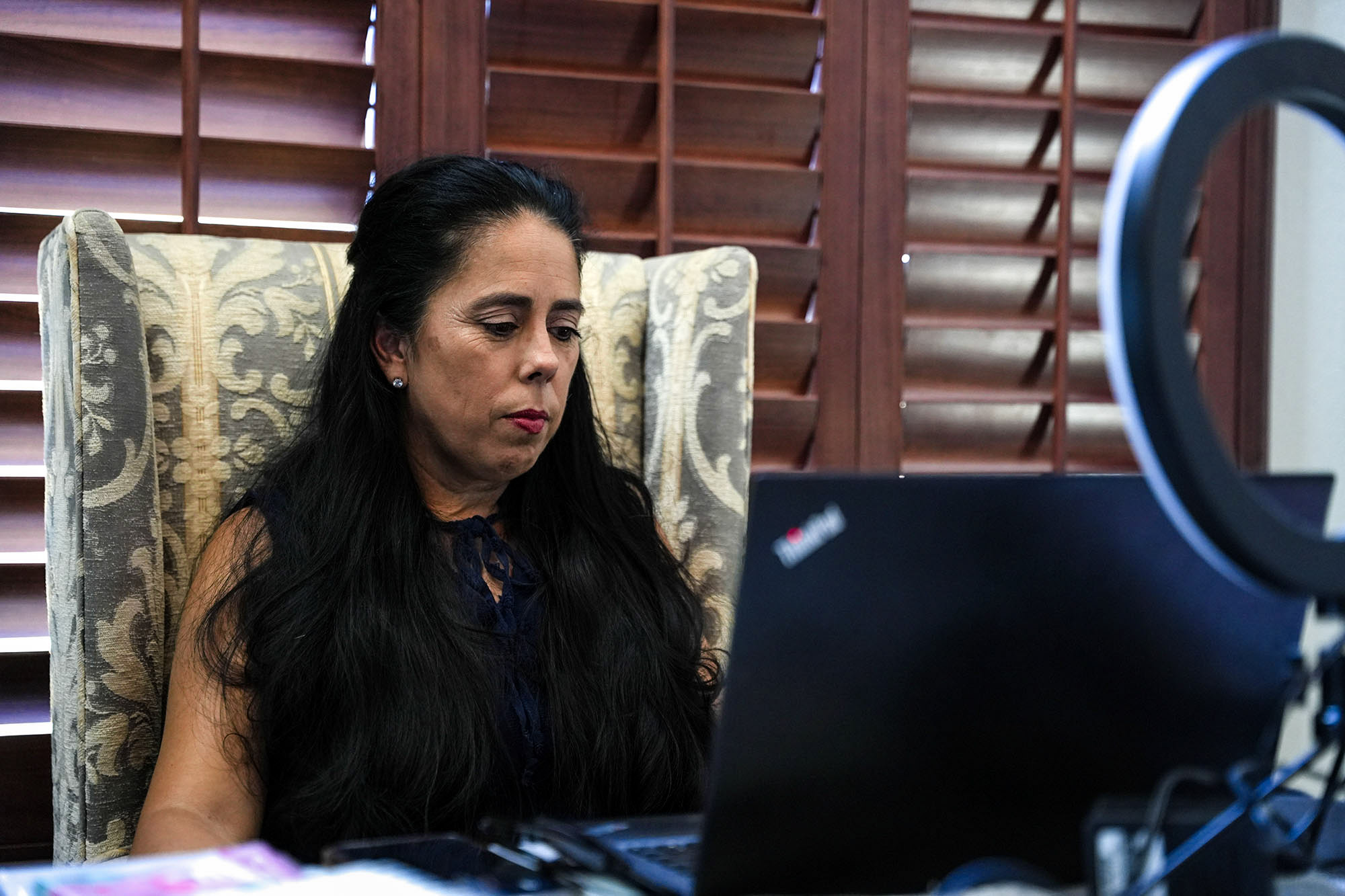Indianz.Com > News > Cronkite News: Nation’s teachers in health crisis
Teachers face mental health crisis because of low pay, pandemic stress, scant support
Tuesday, August 2, 2022
Cronkite News
GILBERT, Arizona — Just weeks before teacher Michelle Capriotti is set to leave her family to take a better-paying job in California, she stands in her living room on a recent afternoon, chatting with her son about the changes coming their way.
“How do you feel about me leaving?” Capriotti asks Christopher, a 17-year-old with special needs, as he makes his way down the stairs.
“They actually called today. You’re fired so you don’t even have to go!” he says in jest.
“Fired from a job I haven’t even started?” she replies, laughing.
Turning away, she notes that Christopher does this whenever her move comes up.
“He is not happy that I’m leaving.”
Capriotti, a public school teacher in the East Valley for more than 27 years, said she took the job in San Jose because she’ll double her pay and get better benefits. Come August, she will fly home every other week to see her family. Even with the cost of airfare, she said, she’ll still be making more money.
Capriotti says her story is common among Arizona teachers. She anticipates a “mass exodus” of educators in coming years – due to low pay, rising stress made worse by the COVID-19 pandemic, and an overall feeling of enough is enough.
“I know more teachers leaving this year than I ever have in my career, and they’re not leaving because they’ve reached the age of retirement,” she said. “They’re tired. It was one thing to hold it together during a crisis, but at some point teachers became the bad guy.
“It’s taxing. It’s frustrating.”

A five-alarm crisis
Navigating low salaries, minimal benefits, short staffing, pandemic worries, exhaustion and burnout: Many teachers would tell you this is the job description of today’s educators.
The result, studies show, is a widespread and growing mental health crisis among U.S. teachers – a problem so grim that many are leaving the field or, like Capriotti, making drastic lifestyle changes.
Long before the pandemic, 46% of K-12 teachers reported high levels of job-related stress, according to a 2014 Gallup report on the state of America’s schools.
Fast forward to 2022. A new RAND report finds that 73% of teachers feel frequent job-related stress, 28% have symptoms of depression, and 59% report burnout. Rates of burnout and depression are highest among teachers of color.

‘I’m tired’
For nearly 20 years, Sydney Francis taught at schools in Flagstaff before she left the field in 2018. She primarily taught art classes to elementary and middle school students, but as a mother of two children, she said that she struggled financially throughout her career.
Ultimately, she said, lack of community support and budget cuts that spurred the “Red for Ed” protests in 2018 persuaded her to quit.
“Toward the end, we took pay cut after pay cut – one to health care, one to salaries – and it was like, ‘I already can’t afford to live, and I’m stressed and I’m tired,’” she said. “And then on top of that, I just didn’t feel supported in my community anymore.”
Francis said some of the main stressors throughout her career involved being chronically short-staffed.
Instead of employing teaching assistants, schools often asked teachers to monitor recess, meaning they didn’t have time to eat lunch or prepare afternoon lesson plans. Or teachers were asked to stand outside and greet students each morning, cutting into morning planning time.
In addition, Francis said that some of her students had special needs and would have benefited from the assistance of a specialized teacher, but those positions often went unfilled.
Given the pressures and her own financial struggles, Francis found it difficult to take care of her students during the day and her own kids at night.
“I felt tapped out by the time I got home,” she said. “I felt like my own kids were getting a less nurturing version of me some days.”
‘Mutual triggering’
When teachers struggle, their students often do, too, experts note.
The WISE Center at MedStar Georgetown University Hospital in Washington, D.C., works to improve the mental health of both students and teachers. The group partners with schools to survey teachers, identify root stressors and take steps to address problems.
Megan McCormick, co-founder and director of programming at the center, said students generally are sensitive to the adults around them, so if a teacher is stressed, a student is more likely to be stressed. She calls the phenomenon “mutual triggering.”
Children who are frequently in high-stress environments tend to mimic the symptoms of behavioral disorders even if they don’t have them. McCormick said this often leads to children receiving treatment for something that could be resolved in the classroom.
“The hard and fast of it is that there aren’t enough therapists, at all, to treat every kid who looks like they have some sort of emotional or behavioral problem,” she said. “By paying attention to the mental health of teachers, we can make such a big impact, with fewer resources, on children.”
In one case, the WISE Center collaborated with a school to provide free counseling services for teachers. About half took part, and all who did reported feeling less stressed.


The last straw
Since she started in 1995, Capriotti has taught grades 6 through 12, as well as special education and physical education in the Chandler and Gilbert school districts. Although state funding and salary have always been concerns, the pandemic was a bleak turning point for her.
First came the challenges of transitioning to virtual learning. Then when in-person instruction resumed, she said, she knew of classrooms with little ventilation that often had up to 35 pupils.
“People didn’t understand that I came home to a family,” Capriotti said. “It would be one thing for me to get COVID; it would be another to give it to my husband, who is a stroke survivor. We were told by medical professionals that COVID would be a death sentence for him, and yet that was never perceived as a viable reason for anyone to hold off on returning to classrooms.”
When the public began taking its frustrations out on educators – volatile school board meetings that made the rounds on social media are just one example – she felt like teachers became scapegoats and were left hung out to dry.
“I have two master’s degrees and I am two years into a Ph.D. program. I’ve spent 20 years in the profession, yet I make $63,000 per year. Tell me what profession with that level of education and that level of experience has that level of pay.
“Then to be demonized on top of it – that was the straw that broke the camel’s back.”
Capriotti explored jobs in other Arizona districts but said she would’ve made even less – “anywhere from a $4,000 to $7,000 pay cut just by switching districts.”
Her new job in the East Side Union High School District in San Jose offers more than twice her Arizona salary, a stark increase in insurance benefits and overtime pay. Capriotti plans to fly from Phoenix to the Bay Area at 5 a.m. on Mondays to get to her job by 8 a.m. When she flies back to Phoenix for a weekend, she won’t touch down until 9 p.m. on Fridays.
Like Francis, Capriotti said her burnout took a toll on her relationship with her children.
“You do give so much of yourself, and our families suffer because of that,” Capriotti said. “I have four children, and they’ve gotten a very tired mother, a very stressed out mother, sometimes a mother who comes home and wants to check out.”
Research shows that nationwide, women report experiencing more pandemic-related stress than men, in part because they often play a bigger role in juggling childcare or family responsibilities with careers.
In Arizona, 76% of all teachers are women. The 2022 RAND report found that 78% of female teachers in the U.S. felt frequent stress, compared with 59% of men.
When asked about the availability of mental health resources for teachers, Capriotti snickered and said her insurance covered 10 counselor visits.
“There’s not a whole lot that you can fully deal with in 10 visits … and, also, who has the time?” she said. “They’ll schedule a counseling appointment at 10 o’clock on a Tuesday, but at 10 on a Tuesday you’re teaching a class, so there’s very little support out there.”
When Capriotti’s daughter, Caitlin, decided to spend a year working as a substitute teacher before entering law school, she offered some solemn advice about teaching in Arizona: “Don’t love it too much.”
For more stories from Cronkite News, visit cronkitenews.azpbs.org.
Note: This story originally appeared on Cronkite News. It is published via a Creative Commons license. Cronkite News is produced by the Walter Cronkite School of Journalism and Mass Communication at Arizona State University.
Search
Filed Under
Tags
More Headlines
Ernie Stevens: Protecting tribal sovereignty in a new political era
Rhonda LeValdo and Gaylene Crouser: Not In Our Honor
AUDIO: Legislative Hearing on H.R.410, H.R.412, H.R.504 & H.R. 741
Native America Calling: Native in the Spotlight with Tatanka Means
VIDEO: ‘Thank you for your leadership’: Sen. Lisa Murkowski (R-Alaska) to Sen. Brian Schatz (D-Hawaii)
VIDEO: Senate Committee on Indian Affairs Organizational Business Meeting
Alaska Beacon: Trump administration faces lawsuit over tribal gaming facility
Native America Calling: Medicaid’s next chapter in Indian Country
H.R.43, the Alaska Native Village Municipal Lands Restoration Act
H.R.42, the Alaska Native Settlement Trust Eligibility Act
H.R.226, the Eastern Band of Cherokee Historic Lands Reacquisition Act
House Subcommittee on Indian and Insular Affairs holds first hearing
Native America Calling: Rising home insurance rates put more Native Americans at risk
Citizen of Navajo Nation tapped for Indian Affairs post
Native America Calling: Native Bookshelf with Ann-Helén Laestadius
More Headlines
Rhonda LeValdo and Gaylene Crouser: Not In Our Honor
AUDIO: Legislative Hearing on H.R.410, H.R.412, H.R.504 & H.R. 741
Native America Calling: Native in the Spotlight with Tatanka Means
VIDEO: ‘Thank you for your leadership’: Sen. Lisa Murkowski (R-Alaska) to Sen. Brian Schatz (D-Hawaii)
VIDEO: Senate Committee on Indian Affairs Organizational Business Meeting
Alaska Beacon: Trump administration faces lawsuit over tribal gaming facility
Native America Calling: Medicaid’s next chapter in Indian Country
H.R.43, the Alaska Native Village Municipal Lands Restoration Act
H.R.42, the Alaska Native Settlement Trust Eligibility Act
H.R.226, the Eastern Band of Cherokee Historic Lands Reacquisition Act
House Subcommittee on Indian and Insular Affairs holds first hearing
Native America Calling: Rising home insurance rates put more Native Americans at risk
Citizen of Navajo Nation tapped for Indian Affairs post
Native America Calling: Native Bookshelf with Ann-Helén Laestadius
More Headlines

